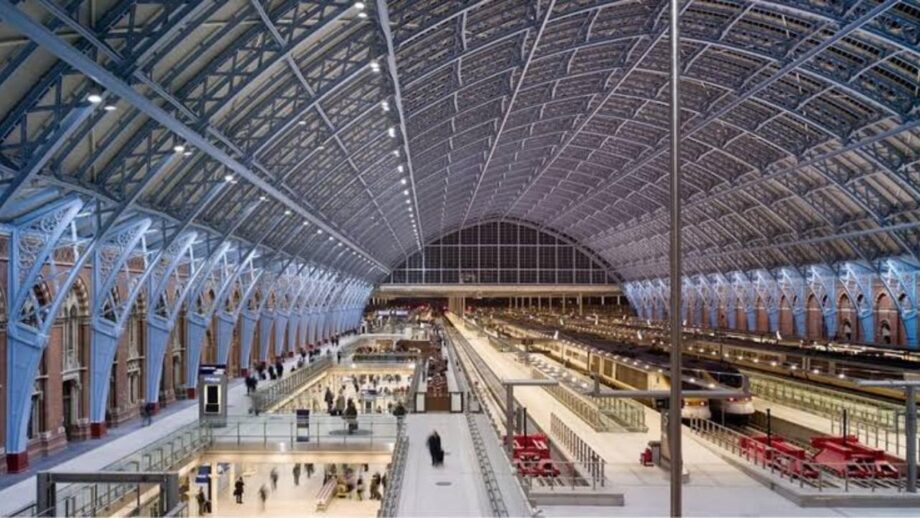Railway stations look so good, considering they are essentially functional structures whose sole purpose is to carry you from wherever you are to somewhere else. But, in reality, towering structures, palaces, and cathedrals devoted to the power of the stream and the technology that supplanted it were inspired by the railway, making them some of the most iconic municipal architecture of the previous 200 years.
They do not need practical infrastructure to appear dated or routine by building cross-country and cross-continental travel networks. Don’t trust us? Here are ten railway stations from across the world that are so amazing you won’t even care if your train is delayed, spanning a variety of styles, ages, and continents.
1. Napoli Afragola, Naples: Despite Mount Vesuvius, one of Europe’s most active volcanoes, looming over it like some bio-mechanical beast slithering across the high-speed rail line connecting Naples and Salerno, Afragola nevertheless manages to attract the attention. The station’s layout allows its many components to move independently of one another and, ideally, remain intact should the earth begin to quake.
2. Gare do Oriente, Lisbon: Lisbon’s Gare do Oriente, a Gothic-inspired metal and glass pavilion, opened in time for the massive “Expo ’98” world exposition to receive the influx of millions of tourists. With a basement shopping center and police station serving as its concrete “roots,” the towering design by Spanish architect Santiago Calatrava was created to maximize natural light during the day. At night, it resembles an illuminated forest.
3. Chhatrapati Shivaji Terminus, Mumbai: Although Chhatrapati Shivaji is still referred to informally as “VT” in honor of its former name, Victoria Terminus, it has little in common with Britain’s magnificent Victorian railroad, St Pancras. The building is quite impressive with its numerous domes and spires. It also has a four-meter-tall marble statue that represents the concept of progress. It is even more magnificent than George Gilbert Scott’s Gothic red-brick design. Since 2004, Chhatrapati Shivaji has been a Unesco World Heritage Site, making it one of Mumbai’s most famous structures.
4. Gare de Metz-Ville, Metz: Although the city’s main station initially gives the impression of being a church that has been transformed into a station, it is a remnant of the imperial past rather than a place of worship. It is the fourth railroad station to occupy this location. Although it has been there for over a century, Kaiser Wilhelm II constructed it in 1908 to proclaim German dominance over the area. It features a stained-glass window depicting the Holy Roman Emperor Charlemagne and private quarters for the Kaiser.
5. Kanazawa Station: The city’s primary train station is a remarkable synthesis of the past and present. In front of the station is a large torii gate made of traditional wood, like the ones found at Japanese shrines. The station’s entrance is covered by the Motenashi Dome, a sparkling structure made of glass and aluminum. Every detail has been meticulously thought out, including the platform columns decorated with gold leaf, a famous export of Kanazawa.
6. Estación Central, Santiago: Officially known as Alameda (after the main street in the Chilean capital), Estaçion Central was established in 1885; however, it wasn’t until the current structure’s opening in 1897 that it gained notoriety, which is perhaps not surprising given that Gustave Eiffel designed it. A large, elaborate steel roof that sweeps across the entire structure like an enormous albatross is affixed to two beautiful white colonnaded station buildings on either side of the tracks.
7. Huddersfield Station: Pevsner and Betjeman, among other architectural experts, praised Huddersfield Station, a Corinthian palace of a station. The design for Huddersfield, which is lavish even by Victorian termini standards, was a collaboration between two train companies to connect the two with a single, especially ostentatious, centerpiece. The oil painting of Felix, the “senior pest controller,” should be admired by guests.
8. Central do Brasil, Rio de Janeiro: For very obvious reasons, railway stations are typically rather horizontal. However, this one in the heart of Rio boasts a 400-foot-tall Art Deco tower that is infamous for consistently showing the wrong time. The station was originally home to the now-defunct Estrada do Ferro Central do Brasil railway system headquarters.
9. Grand Central, New York: Possibly the world’s most well-known train station. Even if you’ve never visited Grand Central Station in New York, chances are you’ve seen it in films like “North by Northwest” and “The Avengers.” It is also well known for its works of art, including a massive (albeit slightly inaccurate) star chart mural that hangs from the main concourse’s ceiling and a variety of well-known interior and exterior murals, sculptures, and paintings.
10. Dunedin Station: Although he had supposedly favored an alternate design with a “Scottish manor house” character, architect George Troup became known as “Gingerbread George” thanks to this fairytale castle made of basalt and limestone. The facility, which once housed New Zealand’s busiest station but has since witnessed a sharp fall in traffic, is now home to the New Zealand Sports Hall of Fame, a restaurant, and an art gallery. In addition, the main platform is changed into the “largest runway in the world” each year for a fashion show.


